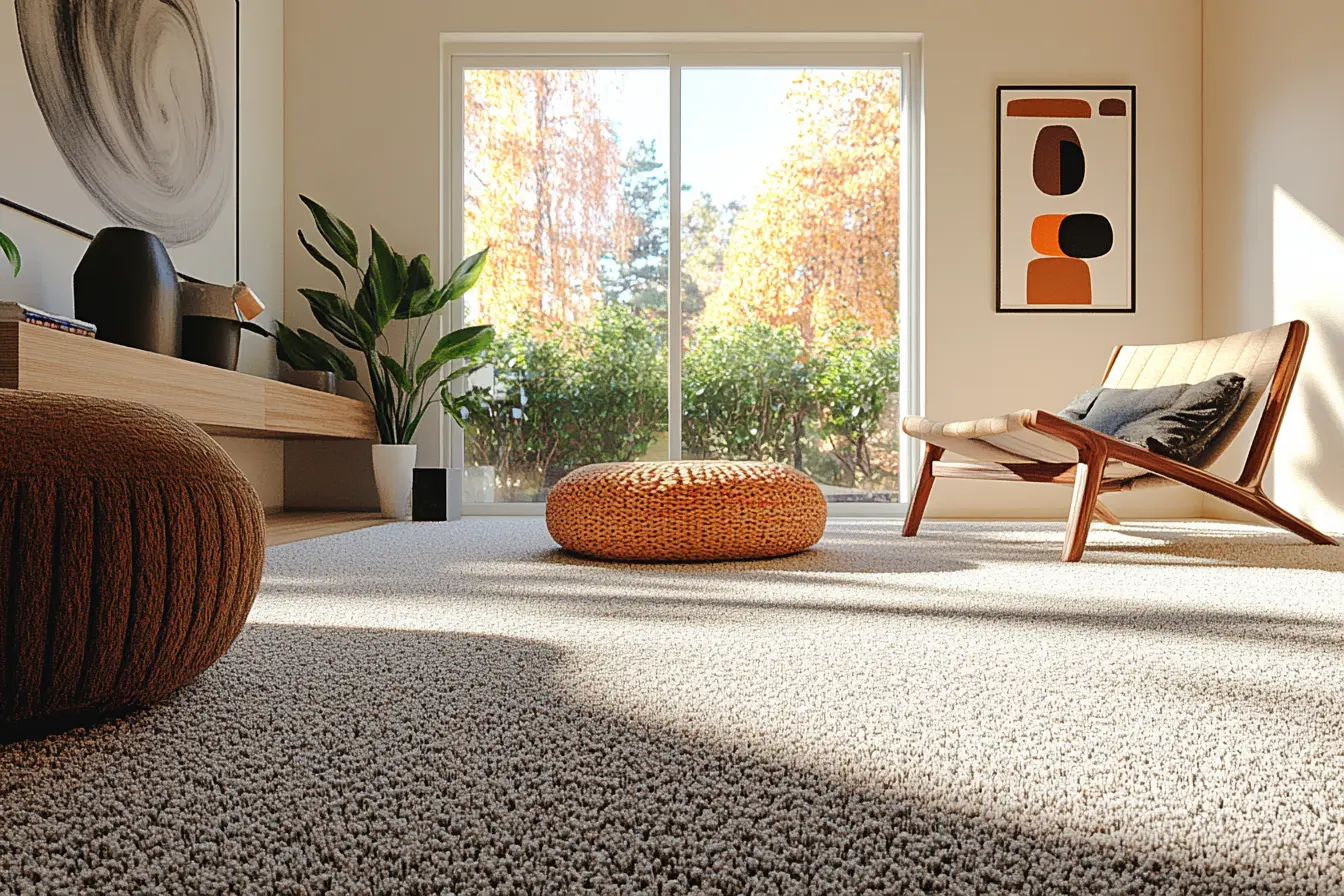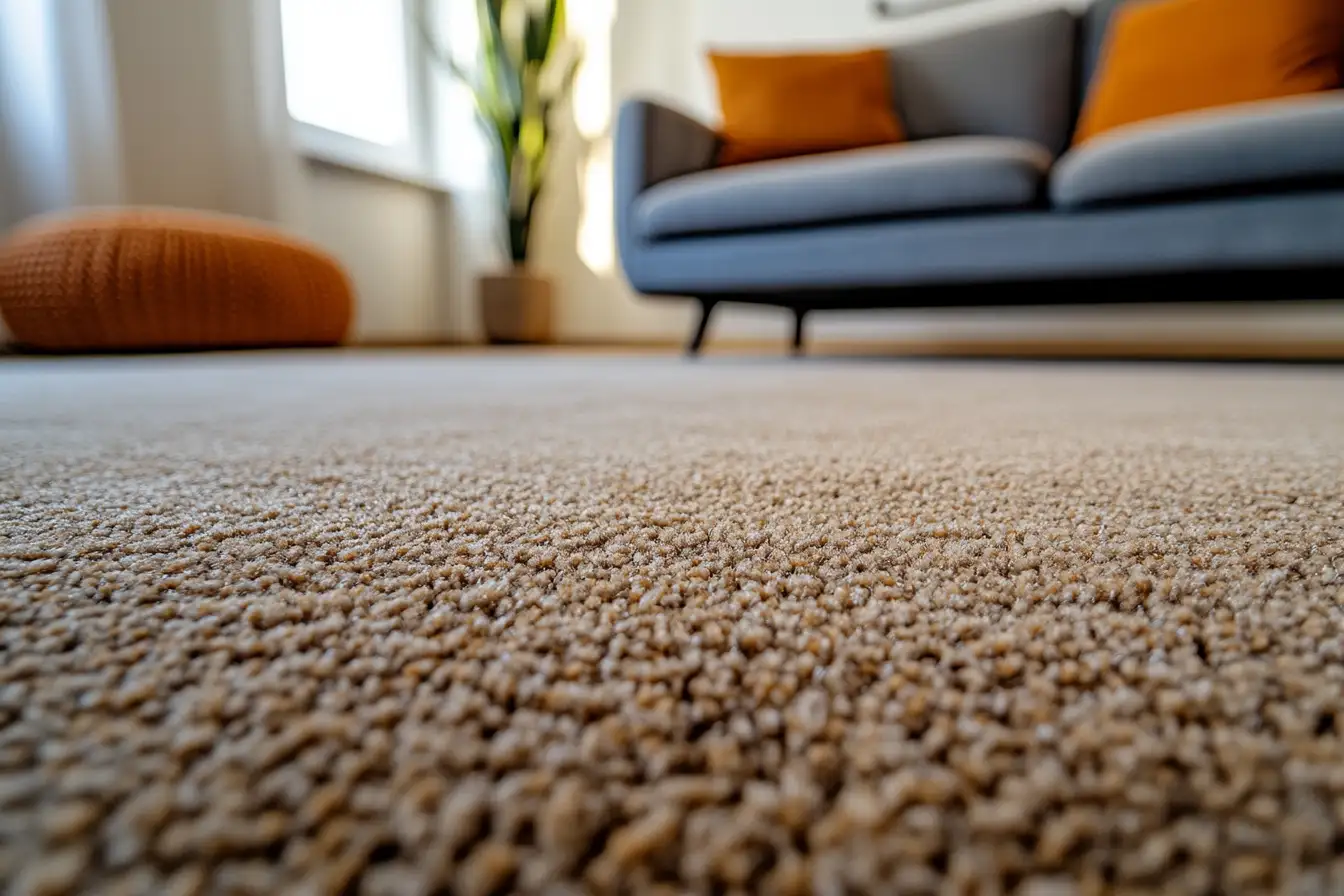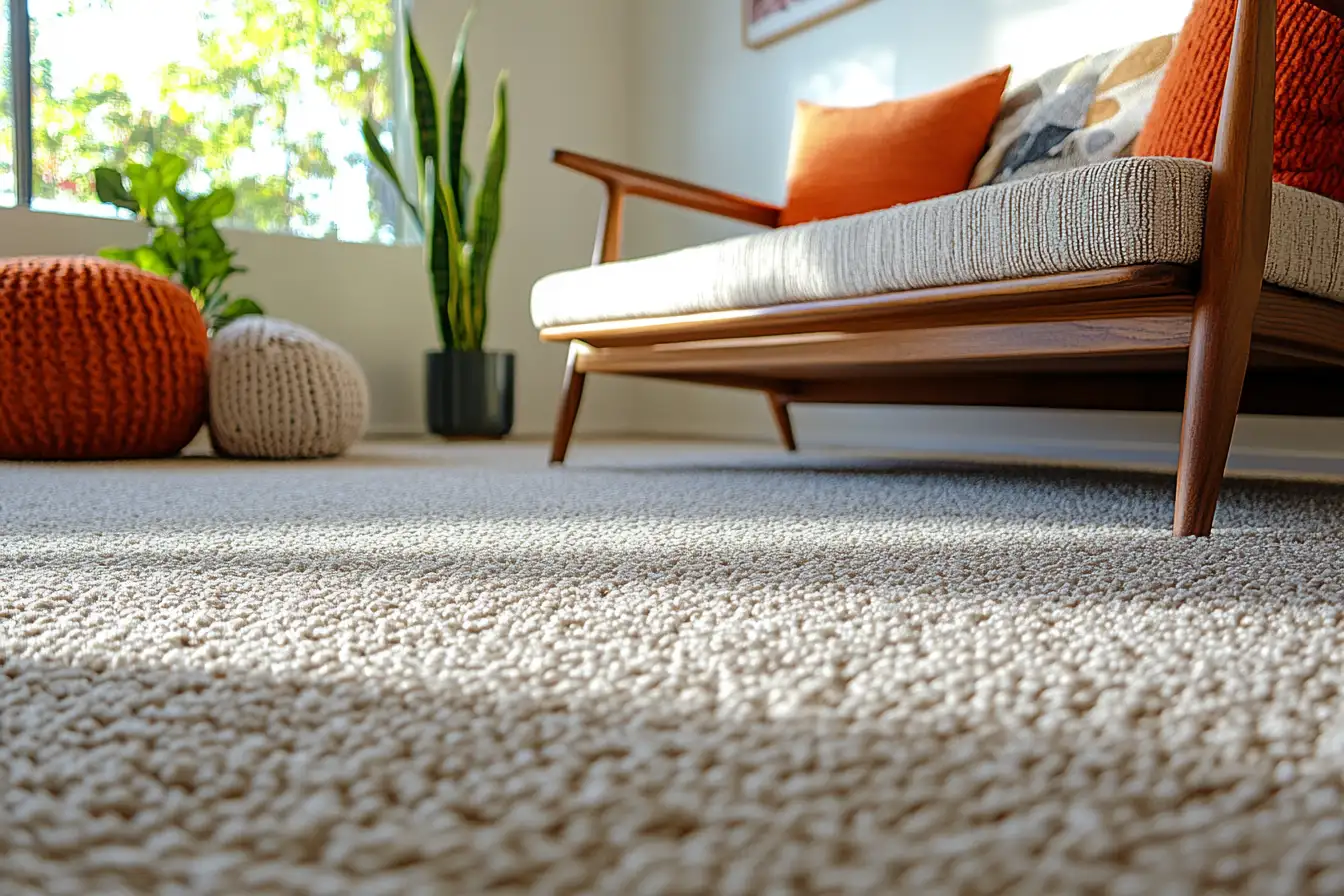Carpet Fitting Cost: Ultimate UK Cost Guide [2025]

We may earn a commission on sales through links at no extra cost for you.
Are you thinking about getting new carpets fitted in your home? As someone who’s recently gone through this process, I know how tricky it can be to understand all the costs involved. In this guide, I’ll break down everything you need to know about carpet fitting costs in the UK and share the best money-saving tips with you!
Key Takeaways:
- Average carpet fitting costs for a 20m² room range between £400 – £800 in the UK
- Labor costs for carpet fitting usually range from £5 – £10 per m²
- Factors affecting price include carpet type, room size, and additional services
- DIY installation can save money but requires skill and proper tools
- Professional fitting often provides better results and includes guarantees
What Affects Carpet Fitting Costs?
I’ve found that several factors influence the overall cost of carpet fitting:
- Carpet type: Synthetic carpets are generally cheaper than wool ones.
- Room size and shape: Larger or irregularly shaped rooms require more materials and labour.
- Subfloor condition: Poor subfloors may need extensive preparation, increasing costs.
- Underlay quality: Better underlay costs more but improves comfort and carpet longevity.
- Installation complexity: Stairs and unusual shapes require more time and skill.
- Location: Labour rates vary across the UK, with London and the South East generally being pricier.
- Additional services: Furniture moving, old carpet removal, and door trimming can add to the cost.
🫰 Breakdown: What does Carpet Fitting Cost in the UK?
Carpet fitting costs in the UK can vary widely based on several factors I mentioned above. On average, you can expect to pay between £20 and £40 per m² including fitting. Here is an overview of typical carpet fitting jobs:
| Overview | Material | Labor | Total |
|---|---|---|---|
| 10m² room | £150 - £300 | £50 - £100 | £200 - £400 |
| 20m² room | £300 - £600 | £100 - £200 | £400 - £800 |
| 30m² room | £450 - £900 | £150 - £300 | £600 - £1,200 |
| Flight of stairs | £150 - £300 | £200 - £400 | £350 - £600 |
Cost Example: Carpet Fitting Cost in a 30m² Living Room
Here’s a more detailed example for fitting a mid-range carpet made out of Nylon in a 30m² living room in the Greater London area. This example includes some extra costs which people often don’t calculate in:
| Overview | 1m² | 30m² |
|---|---|---|
| Nylon carpet (mid-range) | £20 | £600 |
| Underlay | £7 | £210 |
| Carpet fitting | £5 | £150 |
| Old carpet removal | £1.50 | £45 |
| Grippers and door bars | - | £45 |
| Furniture moving | - | £30 |
| Total Cost | £36 | £1,080 |
🧶 7 Popular Carpet Materials: Their Costs, Pros and Cons
To help you choose the right carpet, let’s compare popular types of carpets including their pros, cons and material cost excluding fitting cost:
1. Polypropylene
- Cost: £5 – £15 per m²
- Pros: Very affordable, stain-resistant, easy to clean, available in a wide range of colours
- Cons: Less durable than other options, can flatten quickly, prone to static buildup
2. Polyester
- Cost: £8 – £20 per m²
- Pros: Stain-resistant, affordable, soft texture, good colour retention
- Cons: Less durable than wool or nylon, can be prone to shedding, not ideal for high-traffic areas
3. Berber
- Cost: £8 – £25 per m²
- Pros: Durable, hides dirt well, good for high-traffic areas, resistant to crushing
- Cons: Can snag or unravel, limited colour options, may feel rough underfoot
4. Nylon
- Cost: £10 – £25 per m²
- Pros: Resilient, easy to clean, durable, good for high-traffic areas, resists wear and crushing
- Cons: Can generate static, less eco-friendly, may fade in direct sunlight
5. Sisal
- Cost: £15 – £40 per m²
- Pros: Natural, durable, eco-friendly, adds texture to a room, hides dirt well
- Cons: Rough texture, difficult to clean, can be moisture-sensitive, limited colour options
6. Wool-synthetic blend
- Cost: £18 – £45 per m²
- Pros: Durable and stain resistant, combines benefits of wool and synthetic fibres, good for high-traffic areas
- Cons: More expensive than pure synthetics, can be prone to static, may still be susceptible to moth damage
7. Wool
- Cost: £20 – £50 per m²
- Pros: Durable, natural, luxurious feel, fire-resistant, biodegradable, excellent insulator
- Cons: Expensive, can be prone to staining, may attract moths, requires professional cleaning
Each type of carpet has its own unique characteristics, making it suitable for different needs and preferences. When choosing a carpet, consider factors such as your budget, the room’s purpose, foot traffic, and maintenance requirements. Btw, if you’re also interested in other flooring types, take a look at my wooden flooring cost guide.

Choosing the Right Carpet
Selecting the right carpet involves more than just price. Consider these factors:
- Durability: High-traffic areas need tougher carpets
- Stain resistance: Crucial for households with children or pets
- Comfort: Consider pile depth and material
- Maintenance: Some carpets are easier to clean than others
- Allergies: Certain materials are better for allergy sufferers
I found that spending a bit more on a stain-resistant carpet for my living room was worth it, given my kids’ tendency to spill things!
Additional Costs to Consider
When budgeting for your carpet fitting, don’t forget these potential extra expenses:
- Stair carpet fitting: £70 – £150 per flight
- Carpet protector: £2 – £4 per m²
- Underfloor heating installation: £50 – £75 per m²
- Floor levelling: £20 – £30 per m²
During my project, I needed some floor levelling in one room, which added about £100 to the total cost.
The Carpet Fitting Process
To help you understand what’s involved in carpet fitting, here’s an overview of the typical steps:
- Room preparation: Clear furniture and remove old flooring
- Floor inspection: Check for any issues that need addressing
- Underlay installation: Lay and secure the underlay
- Carpet laying: Cut, position, and stretch the carpet
- Fitting: Secure the carpet around edges and doorways
- Finishing: Trim excess carpet and refit doorstops
While a professional can usually complete this in a few hours, a DIY job might take significantly longer.
DIY vs Professional Carpet Fitting: Is It Worth It?
While DIY installation can save money, I recommend professional fitting for most carpet projects. Here’s why:
- Expertise: Professionals ensure proper stretching and seaming, crucial for longevity.
- Tools: They have specialised tools like knee kickers and power stretchers.
- Time-saving: A professional team can complete the job much faster than a DIY attempt.
- Guaranteed results: Many professionals offer warranties on their work.
The cost difference between DIY and professional installation isn’t as significant as you might think when you factor in tool hire and potential mistakes.
Choosing the Right Carpet Fitter
Finding a reliable carpet fitter is crucial for a successful project. Here’s how I approach it:
- Check credentials: Look for membership in trade associations like the National Institute of Carpet and Floorlayers (NICF)
- Read reviews: Check online reviews and ask for references from previous clients
- Get detailed quotes: Insist on written quotes that break down all costs
- Ask about experience: Enquire about their history with your chosen carpet type
- Verify insurance: Ensure they have proper liability insurance

🕒 How Long Does It Take to Fit a Carpet?
Professional carpet fitters typically take 2-4 hours to carpet an average room (20m²).
- Small room (up to 20m²): Usually 2-4 hours
- Large room (30-50m²): Typically 4-6 hours
- Whole house (3-4 bedrooms): Often 1-2 days
Factors affecting time include room size, carpet type, floor condition, and furniture moving. For my living room, it took about 2.5 hours. Pro tip: While you can walk on the carpet immediately, avoid heavy furniture for 24 hours to allow adhesives to set.
💷 7 Tips to Reduce Your Carpet Fitting Costs
As someone who loves a good deal, here are my top tips for saving on your carpet fitting:
- Compare quotes: Get at least three quotes from reputable fitters.
- Consider mid-range carpets: They often offer a good balance of quality and affordability.
- Prepare the room yourself: Clear furniture and remove old carpets to reduce labour costs.
- Buy in bulk: If carpeting multiple rooms, you may get a discount on materials and fitting.
- Time your purchase: Look for end-of-season sales or promotions.
- Reuse underlay: If your existing underlay is in good condition, consider reusing it.
- Consider remnants for small rooms: These can be significantly cheaper than full rolls.
🌿 Environmental Considerations and Costs
Eco-friendly carpet options are gaining popularity. While they may have higher upfront costs, they often provide long-term benefits:
- Wool carpets: Natural and biodegradable, but more expensive
- Carpets made from recycled materials: Often competitively priced
- Low-VOC carpets: Reduce indoor air pollution, slightly more expensive
- Recyclable carpets: Some synthetic carpets are now designed to be fully recyclable at the end of their life
While these options may cost more initially, they can contribute to a healthier home environment and reduced environmental impact.
FAQs
Q: How much does carpet fitting cost on average in the UK? A: Carpet fitting costs in the UK typically range from £400 – £800 for a mid-sized room of 20 square metres.
Q: How long does it take to fit a carpet in an average room? A: Most professional fitters can complete an average-sized room (3m x 4m) in 2-4 hours.
Q: Can carpet be fitted over existing flooring? A: It’s possible, but not always recommended. The subfloor needs to be level and stable. Sometimes, it’s better to remove the old flooring first.
Q: Do I need to buy underlay when getting new carpet fitted? A: While not absolutely necessary, underlay is highly recommended. It improves comfort, insulation, and can extend the life of your carpet. Most professional fitters will advise using new underlay with new carpet.
Q: Do I need to move my furniture before the fitters arrive? A: Ideally, yes. While many fitters offer furniture moving services, clearing the room yourself can save time and money.
Q: How soon can I walk on my new carpet? A: You can walk on your new carpet immediately, but it’s best to avoid heavy furniture for 24 hours to allow the carpet to settle.
Q: Can carpets be fitted over underfloor heating? A: Yes, but you’ll need to choose a carpet and underlay suitable for underfloor heating systems.
Q: How often should carpets be replaced? A: With proper care, carpets can last 10-15 years, depending on the quality and foot traffic.
Conclusion
Investing in new carpets can transform your home, adding comfort and style to any room. While the costs can add up, understanding what influences the price and how to save money can help you make the right decisions.
From my experience, balancing cost with quality pays off in the long run. The key to a successful carpet fitting project lies in choosing quality materials and working with reputable professionals.
Don’t hesitate to consult with professionals and get multiple quotes to ensure you’re getting the best value for your money.
Frank is a journalist and home improvement enthusiast who recently bought and renovated his own house. After several challenges and discovering how tricky it can be to find reliable cost information, he decided to share his experiences through practical cost guides.